This page is an archive of past WMRS projects.
Over the years a number of activities have taken place in the clubrooms which included operating model trains, building layouts and chatting with friends. The old layouts are grouped into projects, which are listed below.
Continental Group - HO | Lansdown Junction - N | Permanent Layout | McKendrick Street Yard - OO
The Society's N gauge layout, Lansdown Junction, had its last running session in September 2010. The layout is being reused to form new projects within the Society.
The N Gauge layout of the WMRS is called Lansdown Junction, and whilst based on an actual prototype, it was built to enable all types of N Gauge rolling stock to be run on it. Thus, all track is Peco, fine scale at the viewing side, standard Streamline in the extensive fiddle or staging yard. The layout is fully portable, despite measuring some 18-foot by 10 foot. This allows us to exhibit the layout at our own and other exhibitions. It is also possible (just) to erect it in own of our clubrooms for members and their guest to "play trains" on!
The layout has a central operating well and the track layout takes the form of 2 double track ovals, with a crossover in the middle of the scenic viewing side. The crossover is controlled by a number of interlocking relays, which cut power to the tracks when the junction is set against them, thus preventing nasty collisions. In hindsight we should have lined the section breaks up with the signals - maybe one day. Two freestanding operating panels control everything, one controlling the clockwise tracks and the other the anti-clock tracks. Each panel has two Gaugemaster controllers and section controls. Switching is available to take control of tracks from the other panel to allow shunting (switching) to take place. All points are electrically controlled by push to make switches, the points being operated by Peco point solenoids through Gaugemaster Capacitor Discharge Units.
All mains power and transformers are located safely in a ventilated and fan cooled box which sits on the floor below the layout. These power the controllers, point motors and the LEDs used to show the route set.
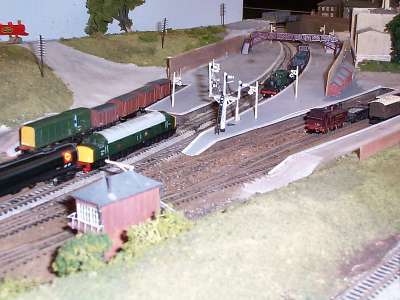
In case you are still unsure where Lansdown Junction, is, or rather was, the station modelled still exists and is the sole remaining station in Cheltenham Spa. The Birmingham and Gloucester Railway, later absorbed by the Midland Railway built it in 1840. The junction itself, was about half a mile south west of the station and connected to the Great Western Railway lines to Cheltenham St. James station; Birmingham, via Honeybourne and Stratford-upon-Avon; Banbury via Kingham and the Midland & South Western Junction Railway to Swindon and Andover. The junction forms the centrepiece of the layout, although it has been flattened to fit the baseboards and to make use of proprietary track.
The period modelled is post World War II, when the track between Cheltenham and Gloucester was doubled, and before 1962, when parts of the junction were removed. This time period allows us to run stock from the old GWR, LMS and Southern with even the odd ex-LNER engine plus of course BR standard types. Ideally at exhibitions, it would be nice to only run correct period stock, but given that it is a club layout, there is a reasonable chance of seeing current liveried or blue and grey stock running. When erected in the clubroom, of course, anything goes provided it is N Gauge and it goes round the curves.
The layout appeared at the 35th anniversary show of the N Gauge Society, of which several club members are also members. Whilst there it played host to some North American stock as well as some Bachman Graham Farish prototypes.
The scenery covers one side and part of the right hand end as viewed from outside. This end covers the fairly sharp curves to the fiddle yard and also attempts to disguise the fact that the tracks that are supposed to go to Cheltenham St James and Malvern Road turn sharp left where in reality they go straight on. At the opposite end, there was no convenient scenic break, so the tracks simply go onto a bare board that is fronted by an information panel. I probably should put a piece of painted board for them to burrow under.
The scenery itself is plaster-covered expanded polystyrene insulation sheets, carved to shape, with the usual Woodland Scenics undergrowth and trees, from the same source and Set Scenes' Forest in a Box trees have also made an appearance but are not so robust. Much is covered in various acrylic paints to produce the right effect of roads paths etc.
Structures include scratch-built models of the station building, which in reality still exists, and of the bridges under Lansdown Road itself plus resin and plastic buildings from Shire Lane, and Kestrel. The two signal boxes are Ratio Midland Railway boxes, absolutely right for the job. The one on the platform was extensively modified. A start has been made on signalling and the signals are a mixture of Ratio and PD Marsh kits. They follow the correct signal diagram, which uses a lot of arms! There is a very nice gantry built out of Ratio parts at the Gloucester end of the layout. All are non-working, there are some things I draw a line at (contrary to popular belief) and working semaphore signals in N gauge is one of them!
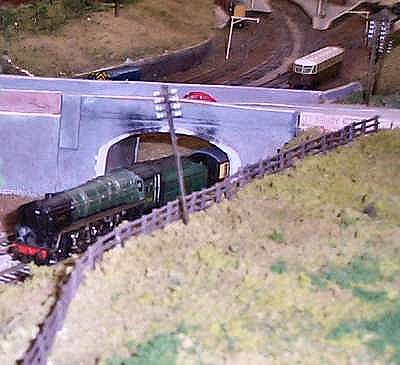
There is still much to be done, the station platforms still await their canopies, whilst some of the householders of the Gloucester Road still wait for their gardens to have the "Ground Force" treatment as well as fences to stop any pets running riot.
I would like to make some modifications to the fiddle yard to get trains to work around the layout in a more prototypical fashion, the layout lighting needs improvement, sorry Argos, you have done well but…, and some walkabout controllers would stop everybody falling over each other but as a club we do not take things too seriously and there is always that important job of playing trains to get on with!
The Permanent Layout was dismantled when the old clubrooms were removed in September 2008. A replacement will be installed in the future when the new clubrooms are complete.
The permanent layout is a major asset in that it is permanently erected and ready for use at any time. Many other clubs have to unpack and assemble their layouts before they can use them, then to put them away by a set time. The layout offers, in addition to a number of stations, a continuous run including reasonable gradients, of about 100ft, suitable for most makes of rolling stock (OO/HO) together with a dual gauge branchline which can also run HOn9 or even ‘N’ gauge.
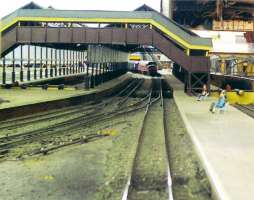
A train under the canopy at the main station. [Photo: Ian McKendrick] |
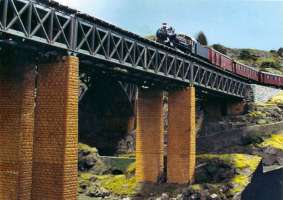 A train on one of the many viaducts. [Photo: Ian McKendrick]
A train on one of the many viaducts. [Photo: Ian McKendrick] |
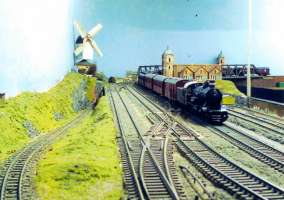
A Danish steam train on the main line. Note the Narrow Gauge tracks to the left. [Photo: Ian McKendrick] |

A Danish sleeper train about to disappear into the tunnel. [Photo: Ian McKendrick] |

The large marshalling yard, used for setting up trains before running on the main lines. [Photo: Ian McKendrick] |
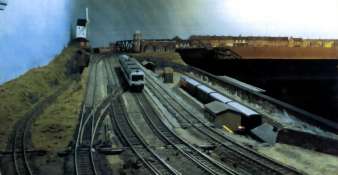
A train on the main line passes the narrow gauge terminus.[Photo: Ian McKendrick] |
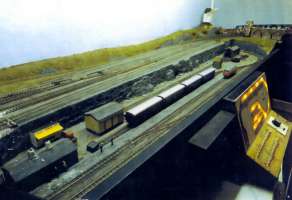
A closer view of the narrow gauge terminus. [Photo: Ian McKendrick] |
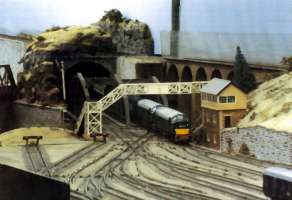
A train emerges from the tunnel into the marshalling yard. [Photo: Ian McKendrick] |
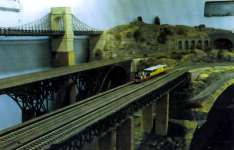
A train crosses one of the layouts three impressive bridges. [Photo: Ian McKendrick] |
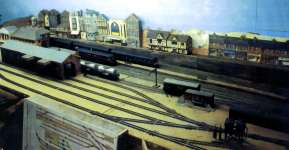
The high level terminus of the branch line. The narrow gauge lines are in the foreground, with standard gauge behind. [Photo: Ian McKendrick] |
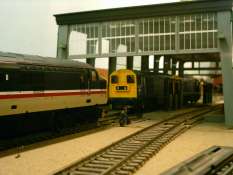
The diesel depot at the terminus [Photo: A. Allum]. |
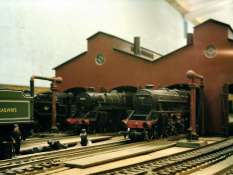
A lineup of locomotives outside the steam shed at the terminus [Photo A. Allum]. |
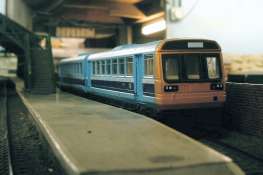
A railbus stands in the bay platform at the main station.[Photo: A. Allum]. |
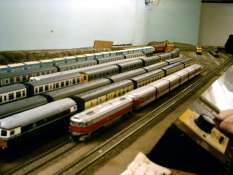
The fiddle yard full of British and Spanish trains. [Photo A. Allum]. |
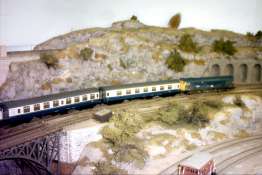
A class 25 diesel rounds the curve into the main station, the branch line is on the embankment above. [Photo: D. Hill]. |
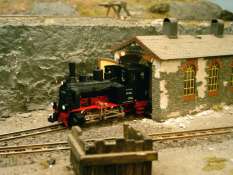
A narrow gauge steam locomotive on shed at the lower terminus. [Photo A. Allum]. |
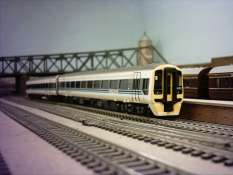
A class 158 DMU stands at the terminus, the main lines cross the bridge in the background [Photo: D. Hill]. |
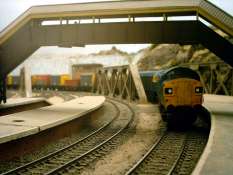
A class 37 diesel loco leads a freight train through the main station. [Photo A. Allum]. |
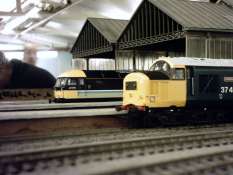
Class 37 and 47 locomtives await departure from the main station. [Photo: D. Hill]. |
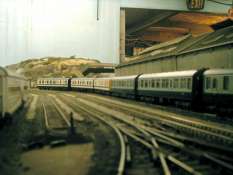
Two DMUs stand at the main station. [Photo A. Allum]. |
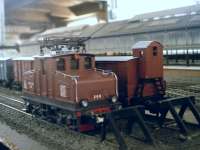
A Swedish shunting locomotive modified from Roco's model of the DB BR169, seen in a siding. [Photo: A. Allum.] |
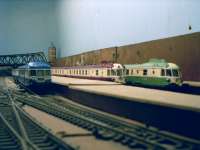
A selection of SNCF trains awaiting duty at the terminus station. [Photo: A. Allum.] |
The continental group looks after the Society’s ‘HO’ gauge layout 'Grunfurter Strasse,' which is in the course of being rebuilt, and will hopefully be ready for 2003. This is based on the German railway system during 1980 – 85.
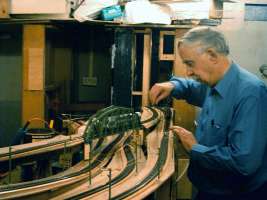 |
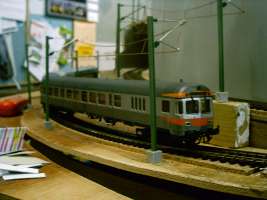 |
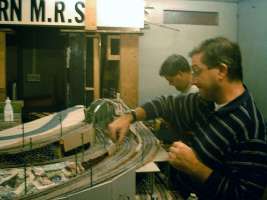
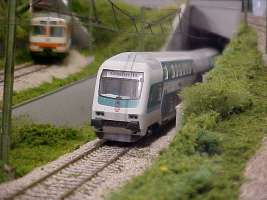 |
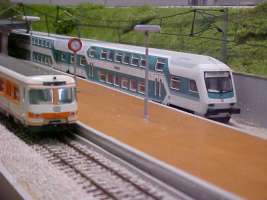 |
Above and Below: Photos of the new German layout, 'Grunfurt Strasse'.
(Click thumbnails below to get the full size image)
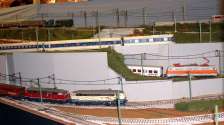 |
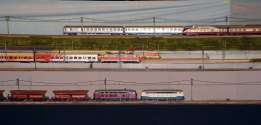 |
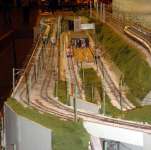 |
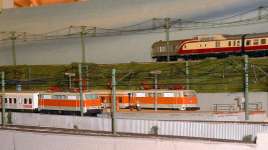 |
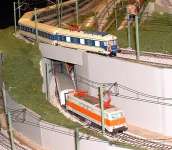 |
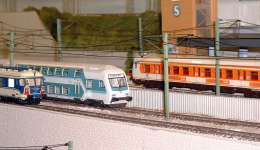 |
Below: Photos of the new town scene.
(Click thumbnails below to get the full size image)
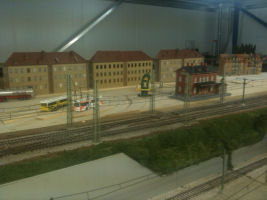 |
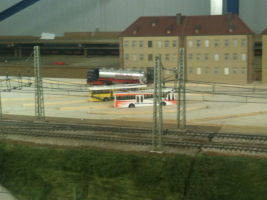 |
This is the smallest Society layout yet. It has been built in memory of Ian McKendrick, 1934 – 2006, who had been the club’s vice president at the time of his death. Ian had given over 40 years of service to the club.
The layout is located in an industrial estate which is operated by locomotives of any UK origin, as it can be sited in any major town in the UK. It has a BR goods depot at one end and a private fuel and scrap yard at the other. The size of the layout , 5feet by 1.5 feet restricts the trains to no more than three standard wagons. This lends it self to a large number of movements, but also to having between two and three locomotives in operation. This means that the layout will be operated using DCC control.
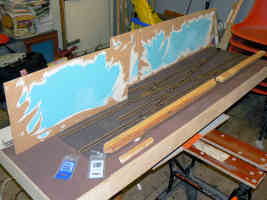
Click for full size image
The layout seen under construction in December 2007. [Photo: D. Hill]
It is a compact single board layout and is designed to fit into a car and requires two operators to cover for meal breaks and rest periods etc.
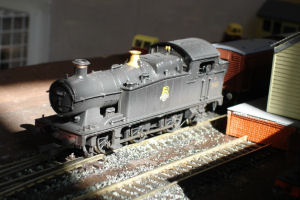
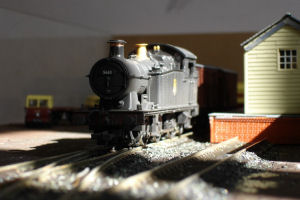
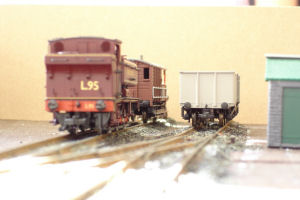
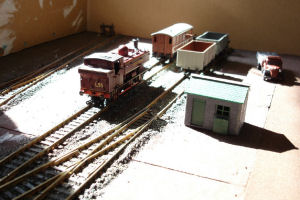
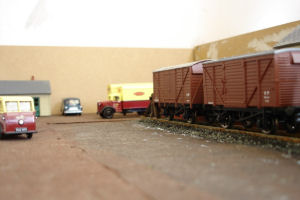
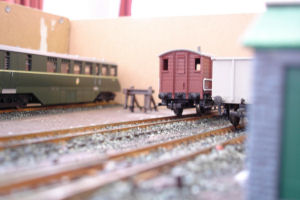
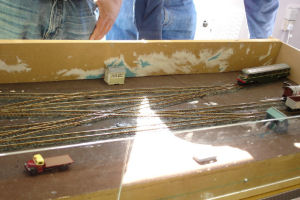
Click for full size image
Above - New photos taken at the Northolt MRCs exhibition, 13th September 2008. They were taken by WMRS member Tim Neale, who was running his layout, St Mark's Yard, at the same show. The rolling stock was supplied by Patrick Boynton, a former member of the WMRS, who came along to assist with running the layout.
McKendrick Street Yard has come along since the 2008 Northolt MRC exhibition. In 2011 McKendrick Street Yard was booked to attend the 2011 Northolt MRC exhibition in September and Swindon & Cricklade Railway's Exhibition in October.
Click for full size image
Above - New photos taken at the WMRS Clubroom. They were taken by WMRS member John Tanner.